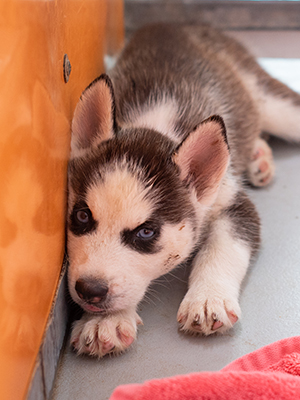8 Tips to Prevent Parvovirus in Your Dog or Puppy
 Canine parvovirus (commonly called parvo) is a highly contagious viral disease that can produce a life-threatening illness in puppies and dogs. It can be transmitted by any person, animal or object that comes in contact with an infected dog’s feces.
Canine parvovirus (commonly called parvo) is a highly contagious viral disease that can produce a life-threatening illness in puppies and dogs. It can be transmitted by any person, animal or object that comes in contact with an infected dog’s feces.
Puppies, adolescent dogs, and adult dogs who are not vaccinated are at risk of contracting the virus. Protecting your puppy or dog from parvovirus could save his or her life.
Keep your dog healthy and parvo-free with these 8 tips:
1. Make sure your dog is properly vaccinated.
Puppies should receive their first vaccines at 6-8 weeks of age; boosters should be administered at 3-week intervals until the puppy is 16 weeks of age, and then again at one year of age. Previously vaccinated adult dogs need boosters every year. Visit The Animal Foundation’s Low-Cost Vet Clinic for affordable dog vaccines administered seven days a week — no appointment needed!
2. Limit your puppy or unvaccinated dog’s exposure to other dogs.
Wait until your dog has had his first two vaccinations, unless you are sure the other dogs are fully vaccinated.
3. Avoid places where your puppy or unvaccinated dog could be exposed to parvovirus from unvaccinated dogs.
Dog parks, pet stores, play groups, and other public areas should be avoided until your dog or puppy is fully vaccinated.
4. When in doubt, err on the side of caution.
Parvo can live in the ground, the grass, on bushes – pretty much anywhere (although it is not an airborne virus). Disease prevention is always less costly (and risky) than treating a condition your pet has developed. Treatments for parvo can frequently cost $1,000 or more while the DA2PPV dog vaccine that includes protection against parvovirus is only $25 at our Low-Cost Vet Clinic.
4. When visiting your vet for wellness check-ups and vaccinations, carry your puppy in your arms outside and leave him on your lap while waiting in the lobby.
Walking where other dogs have walked and gone to the bathroom will increase your puppy’s risk of contracting disease.
5. Parvovirus is very difficult to kill and can live in the environment for over a year.
If you suspect your house or yard has been infected, clean with a 1:32 dilution of bleach (1/2 cup bleach in a gallon of water). Regular soaps and disinfectants DO NOT kill parvovirus. Areas that cannot be cleaned with bleach may remain contaminated. Remember, the virus can survive on a variety of objects, including food bowls, shoes, clothes, carpet and floors.
6. If you work or spend time in places where you have contact with dogs, change your clothes and shoes before returning home to your dog or puppy.
Be sure to wash your hands and othere exposed areas of skin.
7. If your dog or puppy is vomiting, has diarrhea, is not eating or is lethargic, you should take him to the vet as soon as possible.
These are all symptoms of parvovirus. Remember, Infected dogs may show only one symptom!
8. Don’t forget to regularly vaccinate your dog!
Adult dogs can contract the disease, too, if they are unvaccinated. A dog whose immune system is compromised (due to another medical condition) is also at risk for parvo.
For more information on canine parvovirus, visit the American Veterinary Medical Association.
The Animal Foundation’s Low-Cost Vet Clinic offers low-cost puppy and dog vaccines, including the vaccines for parvovirus.

